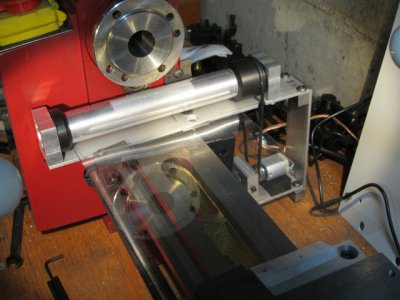- Joined
- Jul 28, 2017
- Messages
- 2,393
This project is an example of finding an application for an idea I had for using a DC motor as a constant torque device. The concept: when stalled, the torque a brushed DC motor exerts is proportional to the current flow through it. Obviously, to avoid burning it up you don't apply full voltage to it.
In this case, the application is an unusual kind of way cover for my mini lathe:

The arrangement is a bit like a miniature roller blind for a window. It's not easy to see, but the way cover is a sheet of mylar wrapped around the roller. Not shown: a cheap PWM motor controller to adjust the drive level to the motor, so it exerts enough torque so the mylar sheet is kept taut but not burn up.
I used ball bearings for the cylinder and motor pulley, but properly-made bushings would work. The bearings I had on hand were pretty stiff due to the grease in them so I soaked them in mineral spirits and then used light lubricating oil -- they aren't under any kind of a load so light oil will be just fine for this.
The little 12V motor is barely up to the task so at some point I may have to get a heftier motor, or greatly increase the reduction ratio in the pulleys. Gear reduction motors would be much stronger but I can't hand turn the shaft on the one I have (the motor has to have some "give" so the mylar can be unrolled when the carriage is moved to the right).
Right now the plastic is just taped to the carriage. The final version will use the steady rest mounting holes and an aluminum bar for a clamp.
I set the roller length long enough so the lead screw also is covered. Hopefully that will help keep swarf off the LS, too.
The only items I needed to buy for this were the bearings (VXB), motor (Jameco), O-ring (local H/W store) and PWM controller (ebay).
Yes, mounting bellows on the lathe would be much simpler, but not near as much fun.
In this case, the application is an unusual kind of way cover for my mini lathe:

The arrangement is a bit like a miniature roller blind for a window. It's not easy to see, but the way cover is a sheet of mylar wrapped around the roller. Not shown: a cheap PWM motor controller to adjust the drive level to the motor, so it exerts enough torque so the mylar sheet is kept taut but not burn up.
I used ball bearings for the cylinder and motor pulley, but properly-made bushings would work. The bearings I had on hand were pretty stiff due to the grease in them so I soaked them in mineral spirits and then used light lubricating oil -- they aren't under any kind of a load so light oil will be just fine for this.
The little 12V motor is barely up to the task so at some point I may have to get a heftier motor, or greatly increase the reduction ratio in the pulleys. Gear reduction motors would be much stronger but I can't hand turn the shaft on the one I have (the motor has to have some "give" so the mylar can be unrolled when the carriage is moved to the right).
Right now the plastic is just taped to the carriage. The final version will use the steady rest mounting holes and an aluminum bar for a clamp.
I set the roller length long enough so the lead screw also is covered. Hopefully that will help keep swarf off the LS, too.
The only items I needed to buy for this were the bearings (VXB), motor (Jameco), O-ring (local H/W store) and PWM controller (ebay).
Yes, mounting bellows on the lathe would be much simpler, but not near as much fun.

